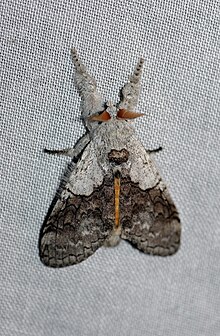| Horsfield's tussock moth | |
|---|---|

| |
| Adult male | |
| Scientific classification | |
| Domain: | Eukaryota |
| Kingdom: | Animalia |
| Phylum: | Arthropoda |
| Class: | Insecta |
| Order: | Lepidoptera |
| Superfamily: | Noctuoidea |
| Family: | Erebidae |
| Genus: | Calliteara |
| Species: | C. horsfieldii |
| Binomial name | |
| Calliteara horsfieldii (Saunders, 1851) | |
| Synonyms | |
| |
Calliteara horsfieldii, or Horsfield's tussock moth, is a moth of the family Erebidae. The species was first described by the British entomologist Edward Saunders in 1851, and named in honor of the British naturalist Thomas Horsfield, who traveled southern Asia and published works on zoology from the region. C. horsfieldii can be found in southern Asia, the islands of the northern Indian Ocean, and many parts of south east Asia and Indonesia. It is also sometimes referred to as the Yellow Tussock Moth.
Distribution
Calliteara horsfieldii is found the tropical portion of southern and southeast Asian including Sri Lanka, Thailand, Singapore, Malaysia, Sundaland, Sulawesi and towards New Guinea and Brunei.
Description
The males of Calliteara horsfieldii show two colour forms. The first has uniform greyish forewings, while the second form has darker greyish colors towards the antemedial side of the forewings. The antemedial side of the forewings is strongly curved. Females of this species have whitish forewings with faint markings. The hindwings of both sexes are similar to one another and have yellowish tinge. The caterpillar is yellowish with rows of dorsal brushes.
As caterpillar, Calliteara horsfieldii is known to feed on many plants such as Etlingera elatior, Anacardium occidentale (the Cashew tree), Mangifera, Casuarina, Begonia, Bixa orellana, Brassica, Albizia falcataria, Dipterocarpus, Hopea, Camellia sinensis (the tea plant), Shorea, Acacia richii, Acacia mangium, Cassia fistula, Casuarina equisetifolia, Cinnamomum zeylanicum (the Cinnamon tree), Cocos nucifera (the Coconut palm), Erythrina, Pterocarpus, Tamarindus (the Tamarind), Lagerstroemia (the Crape myrtle), Ficus, Eucalyptus, Eugenia, Psidium, Syzygium, Pinus (the Pine) and Rosa (the Rose) species.
References
- "Horsfield's Tussock Moth". I Naturalist. Retrieved 7 March 2018.
- "Species Details: Calliteara horsfieldii Saunders, 1851". Catalogue of Life. Retrieved 7 March 2018.
- Koçak, Ahmet Ömer; Kemal, Muhabbet (20 February 2012). "Preliminary list of the Lepidoptera of Sri Lanka". Cesa News (79). Centre for Entomological Studies Ankara: 1–57. Retrieved 7 March 2018.
- "Calliteara horsfieldii (Saunders) pest". ippc.acfs.go.th. Retrieved 7 March 2018.
- "Calliteara horsfieldii (Saunders, 1851) Horsfield's tussock moth". Singapore's Biodiversity. Retrieved 7 March 2018.
- "Calliteara horsfieldii Saunders". Digital Moths of Japan. Retrieved 7 March 2018.
- "Distribution of Calliteara horsfieldii". CABI. Retrieved 7 March 2018.
- "Calliteara horsfieldii Saunders". The Moths of Borneo. Retrieved 7 March 2018.
- "HOSTS - a Database of the World's Lepidopteran Hostplants". The Natural History Museum. Retrieved 7 March 2018.
External links
- Yellow Tussock Moth (Calliteara horsfieldii)
- Torch ginger and Tussock Moth Calliteara horsfieldii
- Final instar caterpillar and metamorphosis of Calliteara horsfieldii (Saunders) in Singapore (Lepidoptera: Lymantriidae: Orgyiini)
| Taxon identifiers | |
|---|---|
| Calliteara horsfieldii | |

